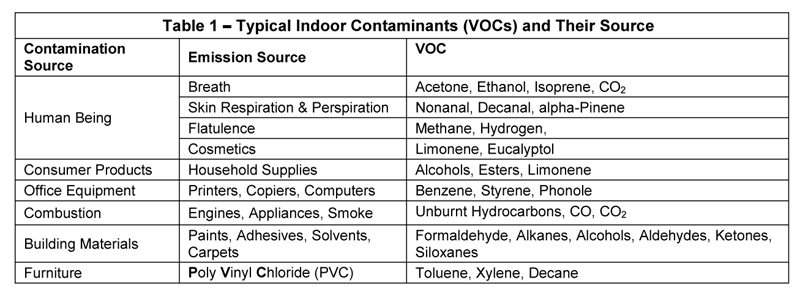This paper will show how BAPI’s Volatile Organic Compound (VOC) sensor is an accurate, reliable and beneficial way of incorporating Demand-Controlled Ventilation into a building’s HVAC strategy.
Ventilating by VOCs vs CO2
Let’s begin a brief of overview of what VOCs are and where they come from. VOCs are chemicals that contain carbon and that evaporate into gases at typical room temperature and pressure. Table 1 shows some typical indoor contaminants and their sources. Some VOCs are harmful to human health and some are not, while some have a smell and some do not.

Rather than VOC levels, most system designers use CO2 levels for their Demand-Controlled Ventilation (DCV)strategy as outlined in the Ventilation Rate Procedure of ASHRAE Standard 62.1. This procedure allows for reduced ventilation rates in unoccupied or minimally occupied rooms to save on heating and cooling costs. The occupancy of the room is determined by CO2 sensors because people breath out more CO2 than they breath in, therefore the CO2 level in a room with minimal ventilation will build up in direct relation to the number of people in it. When the CO2 level rises, additional ventilation is brought in to keep it at an acceptable level.
One drawback with this CO2 method is that it ignores the amount of harmful VOCs that may be present in the air even when the CO2 level is being kept at an acceptable level. That’s why replacing the CO2 sensor with a VOC sensor is becoming more prevalent within the HVAC industry, and why BAPI recommends using our VOC sensors instead of CO2.
Because ASHRAE has not written a ventilation procedure as yet for VOCs, BAPI’s VOC sensor output is correlated to a CO2 level of 0 to 2,000 ppm, allowing the use of ASHRAE’s CO2-based procedure. But will the VOC sensor’s correlated output allow for increased ventilation when people are in the room the same as a CO2 sensor? The answer is yes.
The reason is that a large share of VOCs in an indoor space are generated by the people in the room. Table 1 shows that VOCs come from our breath, sweat and skin or from colognes, perfumes and fabric softeners and other chemicals on our skin and clothes. Because so many VOCs come from people, the VOCs in an occupied space will build up just like the CO2. What this looks like in the real world is shown in the following charts comparing the actual CO2 and VOC levels in a multi-purpose space.
VOC vs CO2 Levels in a Multi-Purpose Space
Extensive research was conducted on occupancy and VOC/CO2 levels in 1,500 offices, schools and homes to determine the relationship between these three factors. The research identified a complex correlation algorithm between VOCs and CO2, and this algorithm is used to create the correlated output of BAPI’s VOC sensor. The accuracy of this output as compared to CO2 levels is shown in the following six charts.
These charts were taken over the course of a typical week in a cafetorium area of a public school in Wisconsin using side-by-side VOC and CO2 sensors. The cafetorium is a true multi-purpose area. It is used for breakfast, morning snacks, lunch, and after school studies during the day, and athletic practices, exercise classes and occasional meetings in the evenings.
The six charts show that the VOC sensor tracks with the CO2 sensor except when additional VOCs are being generated over and above those generated by the people. The HVAC system in the school is using the VOC sensor output to provide the additional ventilation needed when the VOCs are high. Because these VOCs are invisible to the CO2 sensor, the VOC levels would remain high for much longer if the CO2 sensor was being used by the HVAC system rather than the VOC sensor.

MONDAY:
At 7 am, the VOC sensor picks up the breakfast cooking aromas/VOCs. The CO2 sensor climbs a short time later as the students arrive to eat. The VOC sensor has slightly higher readings than the CO2 sensor during breakfast and the morning breaks because the VOCs from the food are added to the VOCs generated by the people. This is also seen at lunch as cooking of the sausage pizza generated lots of VOCs which are added to the VOCs from the students and staff.
Interestingly there is a parent meeting in the room at 6 pm. Notice how the VOCs track slightly above the CO2 during this time but slightly below during the “After School Studies” period. That’s because it’s mostly adults in the space during the “Parent Meeting” and mostly kids in the “After School Studies”. Since adults typically use more perfumes and colognes than kids, and therefore generate more VOCs than kids, the correlation algorithm for the VOC sensor is slightly high during the “Parent Meeting” and slightly low during the “After School Studies”. But whether the VOC sensor tracks slightly high or slightly low, the chart shows that the VOC sensor output directly correlates to the occupancy in the space and that using the VOC sensor output would result in appropriate ventilation.

TUESDAY:
There are again increases in VOCs and CO2 during breakfast, morning breaks, lunch and after school studies. There is a small spike in VOCs at about 5:45 due to Pee Wee wrestling practice which takes place in a performance area just across the hall from 6 to 8 pm. The dining room is used as a rest area for parents and as a place for the wrestlers to store their gym bags during practice, which accounts for the increase in VOCs at that time.

WEDNESDAY:
The daytime portion of Wednesday is similar to Monday and Tuesday with increases in VOCs and CO2 during breakfast, morning breaks and after school studies, and spikes in VOCs due to cooking at lunch. There is a large spike in VOCs at about 4:45 pm due to a general exercise class for students. People generate more VOCs from sweat when they’re exercising, and the students also brought in gym bags and put on exercise clothing which added to the VOCs at that time.

THURSDAY:
The daytime portion of Thursday is similar to the rest of the week with increases in VOCs and CO2 during breakfast, morning breaks and after school studies, and spikes in VOCs due to cooking at lunch. There is an increase in VOCs at 6 pm (similar to Tuesday) due to the Pee Wee wrestling practice in the performance area across the hall. There is another increase in VOCs at 8 to 10 pm due to a parents meeting for the wrestlers in the dining area at that time.

FRIDAY:
The daytime portion of Friday is similar to the rest of the week with increases in VOCs and CO2 during breakfast, morning breaks and after school studies, and spikes in VOCs due to cooking at lunch. There is an increase in VOCs from 6:30 to 8:30 pm due to general student traffic in the area from an athletic event in another part of the school building.

SATURDAY:
The space is considered unoccupied on Saturday so the BMS schedule has the space receiving only the minimum background ventilation regardless of the readings from the sensors.
However, VOCs are being generated in the dining room from about 8 am to noon due to a Pee Wee Wrestling Tournament in the performance center across the hall. Wrestlers store their gym bags and other belongings in the dining area during the tournament, which accounts for the VOCs during that time.
Although the VOCs are mainly from sweat odors in this case, the chart would look the same if the VOCs were from potentially harmful sources such cleaning chemicals or flour strippers. These VOCs would be invisible to the CO2 sensor so they would not be diluted by additional ventilation.
SUNDAY (NO CHART):
Sunday is the only day with no activity in the kitchen and dining area or the surrounding spaces, so there is only background levels of VOCs and CO2 throughout the day.
The Health and Financial Benefits of Low VOCs

Some VOCs cause irritation to the eyes, nose and throat, as well as headaches, drowsiness, dizziness, nausea and fatigue. Other VOCs are known to cause diseases such as cancer. But the importance of detecting and diluting VOCs goes beyond the health concerns. It’s also about productivity and cognitive function.
Although the cooking and sweat odors in the cafetorium charts are not harmful to human health, unpleasant odors – such as burnt microwave popcorn or a stale tuna fish sandwich in a garbage basket – can bring all student productivity to a halt. And the effect is the same in a typical business setting so the additional ventilation to dilute the odors is a good strategy for both schools and businesses.
Besides productivity, a recent study by Harvard, Syracuse and SUNY universities found that VOCs – even in the levels that are typically found in a conventional building – can have a major effect on cognitive abilities.
The study found that on average, cognitive scores were 61% higher on “Low” VOC days versus “Typical” VOC days. And of the nine cognitive areas tested, the largest effects were seen for Crisis Response, Information Usage and Strategy – all of which are indicators of higher level cognitive function and decision making. Specifically the Crisis Response, Information Usage and Strategy scores were 97%, 172% and 183% higher respectively on “Low” VOC days versus “Typical” VOC days.
Another area of the study focused on the financial impact to businesses of ventilating for low VOCs vs typical VOCs. Rather than increased cost, the study found the opposite.

On average, employee salaries account for 90% of the expenses of a typical business, compared to just 10% for utilities, maintenance and mortgage/rent. Because of the low utility costs compared to salaries, the study found that an increase in energy costs of $14 to $40 per person per year to achieve the low VOCs would result in as much as $6,500 in increased productivity per person per year.
According to the principal investigator for study, Dr. Joseph Allen, the study suggests that the health and productivity benefits far outweigh the slightly increased energy costs.
“It is time we move away from ventilation designed for merely acceptable indoor air quality and move towards design for optimal indoor air quality,” Dr. Allen said. “We have been presented with the false choice of energy efficiency or healthy indoor environments for too long. We can – and must – have both.”
If you have any additional questions about the BAPI VOC sensor, please contact your BAPI representative.
Printable pdf Version of this Application Note



